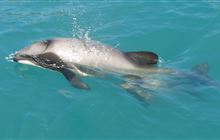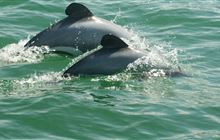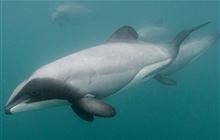Facts about Hector’s and Māui dolphin
Introduction
Information about Māui and Hector’s dolphins and why their populations are threatened.Population size and conservation status
Māui dolphin
A recent population estimate showed that there are only about 54 individuals over the age of 1 year remaining. There is 95% certainty that this number is between 48 and 64.
Māui dolphin has a conservation status of Nationally critical.
Hector’s dolphin
There are about 15,000 Hector’s dolphin older than 1 year – 14,849 animals with 95% confidence that this number is between 11,923 and 18, 492.
Hector’s dolphin have a conservation status of Nationally vulnerable.
Populations are vulnerable to decline
Populations of Hector’s and Māui dolphins are vulnerable to decline for several reasons:
- Short lifespan: Māui and Hector’s dolphins may live until their mid-20s, which is short compared with other dolphins and whales.
- Late maturity: females have their first calf (baby) at 5–9 years of age.
- Low reproduction rate: females produce only one calf every 2–4 years.
All these factors combine to make population increase a very slow process. Māui dolphins may only be able to grow their population by 2% per year, so a population of 63 could only increase by 1 individual per year.
Threats and protection
Fishing, toxoplasmosis and other diseases, oil and gas exploration, boat strike, mining, tourism and noise are all threats to Hector’s and Māui dolphins.
Threats to Hector’s and Māui dolphin.
Like kiwi, Māui and Hector’s dolphins are an iconic part of New Zealand’s natural heritage. If we don’t take care of them, they will be lost forever. The threats they face need to be managed to avoid their extinction. DOC and Fisheries New Zealand have a planning framework to manage these threats.
Our work with Hector’s and Māui dolphin.
Physical features
Different to other dolphins
Māui and Hector’s dolphins look very similar to each other, but different to other dolphins. They have distinctive grey, white and black markings. Their snouts are also a different shape, with no obvious beak. They are the only New Zealand dolphins with a flat, black dorsal fin that looks like one of Mickey Mouse’s ears. Other dolphins usually have a more pointed fin.
There are more than 30 species of dolphin known worldwide, but Māui and Hector’s are the smallest. Females grow to 1.7 m long and weigh up to 50 kg. Males are slightly smaller and lighter.
Māui and Hector's dolphins are close relatives
Māui and Hector's dolphins are two subspecies of the same dolphin species. Māui dolphins used to be known as North Island Hector's dolphins but in 2002 they were classified as a separate subspecies and given the name Māui. The two subspecies are estimated to have been isolated from each other for 15,000 to 16,000 years.
Differences between Hector’s and Māui dolphin
Hector’s and Māui dolphins may look identical, but they are physically and genetically different. Māui dolphins have very slightly larger skulls than Hector’s dolphins and a longer, wider rostrum or snout. Genetic methods are used to tell the subspecies apart.
Dolphin behaviour
Hector’s and Māui dolphins use echolocation to find their food like all toothed whales. Echolocation is like seeing with sound. The dolphins send out ultra-high frequency clicks that bounce off surrounding objects and their prey. These echoes are interpreted as a detailed picture of their surroundings.
Echolocation is a powerful tool that allows dolphins to see fish hiding under the sand and navigate through murky waters.
Food and foraging
Māui and Hector’s dolphins feed on a wide variety of prey, and their diet varies in different populations. They feed throughout the water on bottom-dwelling fish and free-swimming prey, preferring small red cod, āhuru flatfish, stargazer, sprat and arrow squid.
Hector’s dolphins have been seen foraging around fishing boats using trawl nets. They are thought to be hunting the fish on the seafloor that are disturbed by the trawling gear rather than the fish captured in the net. More research is being carried out to understand this behaviour.
Communication
Many dolphin species communicate with whistles but Māui and Hector’s use short, high-pitched clicks. They also communicate with other senses including vision and touch, by slapping their tails on the water or leaping into the air.
The clicks are so high-pitched that humans can’t hear them. The clicks are at about 125 kHz and the top end of the human hearing range is about 20 kHz.
Listen to a recording of Māui dolphin clicks (MP3, 156K)
This recording was slowed down by 20 times so humans could hear it. It was produced by Steve Dawson, University of Otago.
Social groups
Hector’s and Māui dolphins are usually seen as individuals or in social groups of up to about 14 individuals. Hector’s dolphins often form groups of only males or females. Mixed groups are most common for Māui dolphins.
Members of these social groups change their companions often. Males have no role in rearing calves so a female and her calf will often form a nursery group with a few other females and calves.
Māui and Hector’s dolphins live in different places
Māui and Hector’s dolphins are only found around the coast of New Zealand. They live in small, isolated populations that don’t generally mix with each other.
Māui dolphin locations
Māui dolphins live only on the west coast of the North Island from Maunganui Bluff to Whanganui. They were once found along most of the west coast of the North Island from Cook Strait to Ninety Mile Beach. Today, you are most likely to spot one between Manukau Harbour and Port Waikato.
These dolphins are regularly found near the mouths of Manukau and Kaipara harbours and are occasionally seen just outside many other harbours in this area. The same areas are popular for fishing and recreation, so special care is needed to protect dolphins in these places.
Māui dolphins are generally found close to shore in small groups. They are usually seen in water less than 20 m deep but may move further offshore. While individual groups tend to stay along the same 30 km of shore, some individuals have been recorded moving nearly 80 km in less than 3 weeks.
Hector’s dolphin locations
Hector’s dolphins were once found along the coast of most of the South Island as well as parts of the North Island. Today, Hector’s dolphin live in different sub-populations around the South Island. The largest populations are off the coast in these areas:
- east coast between the Marlborough Sounds and Otago peninsula – often in local populations in this area
- west coast between Jackson Bay and Kahurangi Point
- south coast between Toetoes and Porpoise Bays, and in Te Waewae Bay.
While some animals have been recorded off the coast in other parts of the South Island, including a number of sightings in Golden and Tasman Bays, populations in these areas are not well studied.
Hector’s dolphins are occasionally seen around the North Island. They have been recorded from Wellington to Taranaki – even in the area where Māui dolphins live. Sightings on the east coast, including in the Bay of Plenty, have also been reported.



